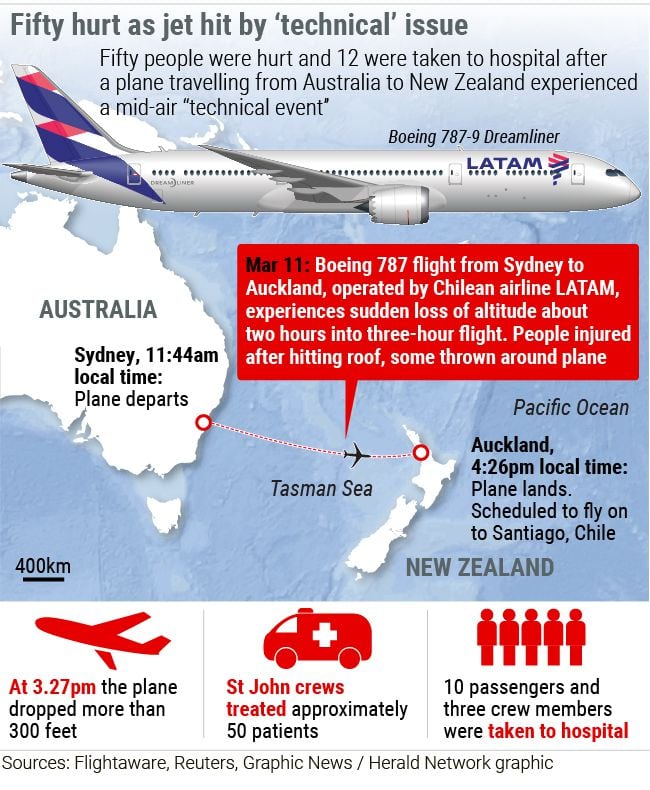Passengers on the Latam plane that plunged mid-flight between Sydney and Auckland have slammed the airline’s apparent lack of communication and how it was treating them after their ordeal.
Brisbane woman Clara Azevedo, 28, said it felt like a “miracle” when the pilot gained control of the plane after feeling it “free fall” for what she thought was about 10 seconds.
“We were not sure if we were going to make it or not,” Azevedo said.
When the Herald spoke to Azevedo, she was with a group of passengers sharing breakfast at the Auckland hotel to which the airline transferred them about 2am.
The shaken passengers were given a single McDonald’s cheeseburger while waiting at the terminal once the plane landed and were not fed again until this morning.
Azevedo said Latam had not offered passengers help or support following the incident, and they were dissatisfied with the communication they had received from the airline.
“We are all traumatised, and we had to find strength to help people out. But this is not our responsibility, it is Latam’s - but they haven’t done anything. That’s very frustrating.”
She was uninjured during the fall, but a 68-year-old woman sitting near her, who did not speak English, broke two ribs and injured her shoulder. Azevedo spent her night translating for her in hospital.
The woman had begged to be discharged with strong pain medicine so she could recover at home, Azevedo said, adding that doctors believed that could take 6-8 weeks.
The passengers were awaiting an explanation of the cause of the “free-fall” incident as some prepared for a long-haul flight to Santiago, Chile – the final destination of flight LA800.
Azevedo and the injured woman are both due to catch the flight at 8 tonight and are feeling “terrified”.
Azevedo was hoping for medicinal assistance to sleep the whole flight or else she didn’t think she would survive it.

Australian Jacob Thompson, 33, said he hit his head and watched his partner get “thrown down the aisle” during the incident.
“We didn’t know if we would make it to landing.”
He said the drop “did not feel like turbulence” and he had never felt anything like it before.
Thais Iwamoto, 26, from Sydney, was sleeping in the emergency row during the initial flight and was jolted awake by the drop.
“So when I woke up and I was falling, I looked to the side and everyone’s screaming and in shock,” she said.
“The guy on the other row, he hit his head on the baggage compartment and he actually like broke the thing.”
She, too, was frustrated by the lack of information from Latam and the treatment the passengers received last night.
“It’s just ridiculous, just so disorganised after what we have been through,” Iwamoto said.
“This [their communications and support] is something I want to talk to them about because it’s not OK. It’s just not fair. Accidents happen, but the way they treat us, that’s not what it’s supposed to be.”
Latam said this morning that the cause of the incident, which it described as a “strong shake”, was under investigation.
A Transport Accident Investigation Commission (TAIC) spokesperson said Chile would be responsible for investigating because the incident occurred in international airspace.
Chile’s Directorate General of Civil Aviation said TAIC would investigate and Chile would send a representative to join the inquiry.
It had asked TAIC for help and evidence was being gathered, including seizing the cockpit voice and flight data recorders.
A Civil Aviation Authority spokesperson said they are supporting the Transport Accident Investigation Commission.
Aviation expert Irene King said it was hard to tell at this stage whether the incident was a system or human-based issue.
She had never seen the “sheer volume” of injuries before, but believed it could be due to clear air turbulence, which typically came with no warning.
“You just go bang into it, like hitting a brick wall.”
However, airlines typically stated “fairly quickly” when clear air turbulence was to blame.
“Airlines don’t usually use the term ‘technical issues’. It just doesn’t feel right in terms of the explanation.”
Former pilot and aviation teacher Ashok Poduval said that, broadly speaking, a sudden loss of altitude could happen if an autopilot system malfunctioned or a plane experienced clear air turbulence.
”I don’t think I ever lost control of an aircraft. That rarely happens. I’ve had all kinds of turbulence,” he told the Herald.
New Zealand Air Line Pilots’ Association (NZALPA) president Andrew McKeen has offered support to the aircrew involved.
He said it was “human nature” to speculate on the cause, but letting the investigation take place without conjecture was the “most responsible approach”.
/cloudfront-ap-southeast-2.images.arcpublishing.com/nzme/HNGT33NQNJAK5JHPGUSFHJKSGU.jpg)
An ambulance at Auckland International Airport after passengers were injured during a Latam flight from Sydney. Photo / Dean Purcell
Fifty people were treated by St John once the plane landed in Auckland and 13 required further treatment in hospital. Four remained in Middlemore Hospital with “significant” injuries, Health NZ Te Whatu Ora said today.
Latam said the injured passengers were from five countries. Ten passengers from Brazil, France, Australia, Chile and New Zealand, as well as three cabin crew, were taken to hospital.
Rachel Maher is an Auckland-based reporter who covers breaking news. She has worked for the Herald since 2022.
Take your Radio, Podcasts and Music with you







